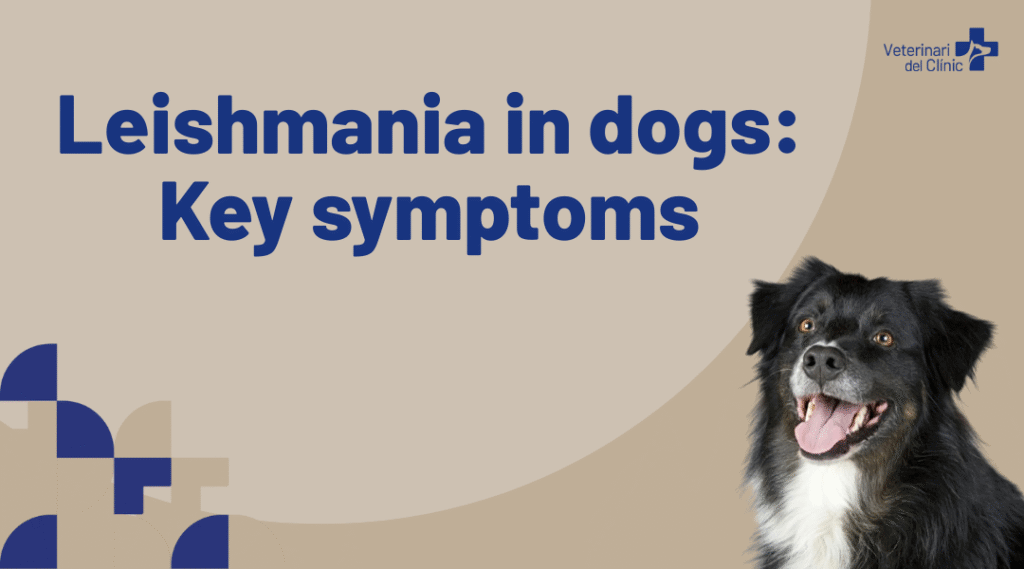Leishmaniasis is a very common disease in dogs in Spain, especially in areas like Barcelona. It is transmitted by a sand fly and can affect both dogs and people.
The most important thing to know is that it doesn’t always present visible symptoms at first: when it affects internal organs (visceral form), it can go unnoticed. However, when signs appear on the skin, we have a valuable opportunity to detect it earlier.
In this article you will find:
- What is Leishmania and why is it a zoonotic disease.
- Common general and visceral symptoms.
- Skin lesions that may alert you.
- How it is diagnosed and treated.
- Tips for year-round prevention.
What is Leishmania and how is it transmitted
Leishmania infantum is a parasite transmitted by the bite of the sand fly, which is most active between spring and autumn.
When a sand fly bites an infected dog and then a healthy dog, it can transmit the disease.
It’s also important to know that Leishmania is a zoonosis, meaning it can affect humans, although human cases are much less frequent and usually occur in people with weakened immune systems.
Therefore, protecting your dog also protects you and your entire family.
Types and Symptoms of the Disease
There are two main forms of presentation: visceral (internal) and cutaneous (external).
Visceral Leishmaniasis: The Most Severe and Silent
The visceral form affects organs such as the liver, spleen, or kidneys, and can progress for months without showing obvious symptoms.
Some signs that may raise suspicion are:
- Unexplained weight loss.
- Fatigue or lack of energy.
- Intermittent fever.
- Nosebleeds or pale gums.
When the disease reaches this stage, treatment is longer and more complicated, which is why early detection is essential.
Cutaneous Leishmaniasis: The One That “Warns” Through the Skin
In many cases, the first symptoms appear on the skin. This occurs when the dog’s immune system manages to keep the infection more localized, and this is where the dermatology service plays a key role.
The most frequent signs are:
- Hair loss around the eyes, ears, or muzzle.
- Wounds that don’t heal or crusty skin.
- Dandruff or flaking.
- Nails that grow longer than normal.
- Dry or thickened skin, especially on the head and paws.
These signs can easily be confused with allergies, infections, or dermatitis, so it’s important to consult a veterinarian if they don’t improve with standard treatments.
Diagnosis: When the skin provides the first clue
At Veterinari del Clínic, cases with suspicious skin lesions are always thoroughly investigated. We combine dermatological examination with specific Leishmania tests (rapid tests or blood tests) and other complementary tests if necessary. The goal is to detect the disease before it reaches internal organs, which greatly improves the prognosis.
Treatment and follow-up
Treatment depends on the stage of the disease and the dog’s overall condition. In mild or cutaneous cases, antiparasitic medications are used in combination with immune-boosting supplements and specific dermatological care. In more advanced cases, close monitoring of internal organs and regular checkups are required.
At Veterinari del Clínic, we provide personalized follow-up for each dog, assessing their progress both clinically and dermatologically.
Prevention: the most important step
Prevention is key and should be maintained year-round:
- Use repellent collars or spot-on treatments that protect against sand flies.
- Annual vaccination against Leishmania (helps reduce the risk).
- Avoid walks at dawn and dusk, when sand flies are most active.
- Check your dog’s skin frequently and see your veterinarian if you notice any changes.
Detecting a lesion early can be what saves your dog’s health (and life).
Conclusion
Leishmaniasis is a serious disease, but the good news is that we can detect and control it early. When it affects the skin, it often gives us an advantage: it warns us before it damages internal organs.
At Veterinari del Clínic, we combine our expertise in dermatology and internal medicine so that no detail goes unnoticed. If you notice wounds or areas of hair loss that aren’t improving, book an appointment. Your dog will thank you for looking beyond the itching.


